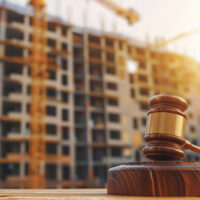What Is the “Scaffold Law” and How Does It Protect Injured Workers?

New York is a city constantly under construction. Here, skyscrapers, apartment buildings, bridges, and brownstones are built, repaired, and renovated year-round. Unfortunately, this never-ending construction boom means that serious workplace accidents are all too common, especially for workers who perform their jobs at dangerous heights.
That’s why New York Labor Law § 240, often called the Scaffold Law, plays such a critical role in protecting construction workers. Labor Law 240 is unique to New York and provides powerful legal rights to workers who are injured in height-related accidents, rights they would not have under ordinary workplace safety laws alone.
At Leandros A. Vrionedes, P.C., we help injured construction workers and their families understand their rights under Labor Law 240 and fight for the compensation they deserve. Here’s what you should know about how this important law works and how it could apply to your case. If you or a loved one has been hurt in a New York City construction accident in Manhattan, the Bronx, Brooklyn, or Queens, contact our office to speak with an experienced and successful NYC construction accident lawyer.
What Is the Scaffold Law?
New York Labor Law § 240(1) (the “Scaffold Law”) is a special section of state labor law that protects construction workers who perform jobs involving elevated work sites, such as scaffolds, ladders, hoists, or any other device used to lift people or materials.
Under Labor Law 240, property owners, contractors, and their agents must provide proper safety equipment and devices to protect workers from gravity-related risks, meaning falls from a height or injuries caused by falling objects.
The purpose of the law is clear: if a worker is required to work at an elevation, they must be provided with adequate, secure safety measures.
What Makes the Scaffold Law Different?
Unlike ordinary negligence claims, Labor Law 240 imposes absolute liability on owners and contractors who fail to provide proper safety protections. This means that if a violation of the law causes a worker’s injury, the owner or contractor can be held fully liable, regardless of whether they were directly negligent in supervising the work.
For example, if a worker falls from a faulty ladder that was not properly secured, or if a scaffold collapses because it was improperly constructed, the owner or general contractor may be automatically liable for the worker’s injuries.
This strict liability standard is why Labor Law 240 is so powerful for injured workers.
What Kinds of Accidents Are Covered by the Scaffold Law?
Labor Law 240 applies to a wide range of height-related or gravity-related accidents, including:
- Falls from ladders, scaffolds, roofs, unfinished storeys, or other elevated structures.
- Accidents involving hoists, pulleys, ropes, braces, or other devices used for lifting.
- Injuries caused by falling, swinging, or rolling tools, equipment, or building materials that strike a worker.
- Collapses of scaffolds or platforms due to improper assembly or maintenance.
The law generally covers construction, demolition, repair, painting, cleaning, and other activities related to building work. However, it does not apply to routine maintenance work or impose liability on owners of one- or two-family homes who do not direct or control the work.
Why Scaffold Law Claims Matter for Injured Workers
In New York, injured workers are usually barred from suing their employer directly because workers’ compensation is the exclusive remedy for employer negligence. However, Labor Law 240 creates an exception, allowing injured workers to bring a separate civil lawsuit against the property owner, general contractor, or other responsible third parties.
This can make a huge difference. Workers’ compensation provides medical benefits and partial wage replacement but does not pay for pain and suffering, loss of quality of life, or full lost income. A successful Labor Law 240 claim can help injured workers recover the full value of their damages, including:
- Medical expenses not covered by workers’ comp
- Full lost wages and loss of future earning capacity
- Pain and suffering
- Permanent disability and loss of enjoyment of life
How Insurance Companies and Defendants Fight These Cases
Because Labor Law 240 is so favorable to injured workers, insurance companies and defense lawyers often fight hard to challenge these claims. For instance, they may argue that the work did not fall under Labor Law 240 or that the accident was not caused by a height-related risk. They might also allege that the worker was the “sole proximate cause” of their injury—for example, if the worker ignored clear safety instructions or misused equipment in an unforeseeable way.
To counter these arguments, it’s essential to work with an experienced construction accident lawyer who understands the nuances of Labor Law 240 and can build a strong, well-documented case.
What to Do After a Height-Related Accident in New York City
If you were injured in a fall or struck by a falling object on a New York construction site, here are some immediate steps you should consider taking:
- Get medical attention right away.
- Report the accident to your employer and make sure an incident report is created.
- Take photos of the accident scene, your injuries, and any equipment involved.
- Get contact information for any witnesses.
- Talk to an experienced lawyer as soon as possible. Do not rely on workers’ comp alone if you may have a Labor Law 240 claim.
Talk to an Experienced New York Construction Accident Attorney
At Leandros A. Vrionedes, P.C., we have years of experience representing injured construction workers in New York and fighting for the full compensation they deserve under Labor Law 240. If you or a loved one has been hurt in a height-related construction accident, don’t assume workers’ compensation is your only option.
Contact us today for a free consultation. We’ll explain your rights under the Scaffold Law, investigate the accident, and hold all responsible parties accountable so you can focus on your recovery.


